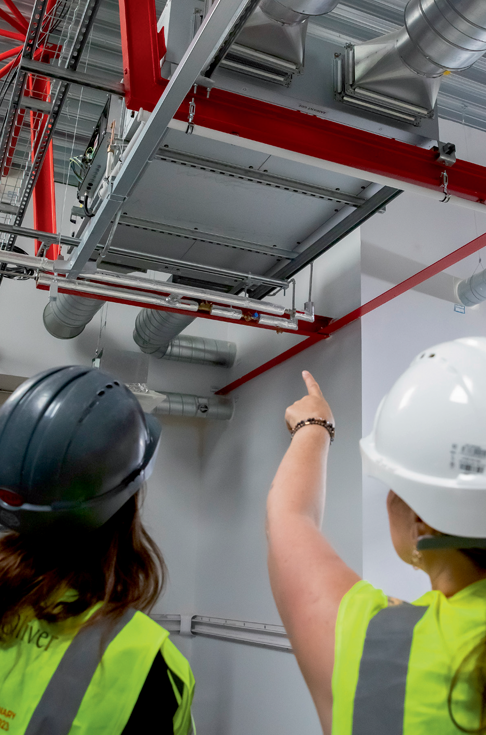 Product
Product
Improving air quality and reducing emissions
Our ambition
/ To champion the energy saving potential of our products and solutions and support the net zero ambitions of the countries in which we operate.
/ To continue to develop clean air solutions that protect people’s health and increase their comfort in an ethical and responsible way.

Defining low-carbon sales and why they matter
We define low-carbon products as those that deliver energy savings once installed in their intended application – both in new buildings and in refurbishments. Specifically, if a product helps a building use less energy in normal operation, and does so beyond the legal minimum, we count it as low-carbon.
By driving our low-carbon sales, we know we are delivering on our purpose to provide healthy air sustainability.
 New build
New build
In new buildings, ‘qualifying products’ reduce energy use and associated carbon emissions, verified through national calculation methods or recognised efficiency schemes.
Across our European businesses, this is shaped by the Energy Performance of Buildings Directive (EPBD), with each country operating its own models.
In the UK, qualifying products include those in the Standard Assessment Procedure (SAP) – transitioning to the Home Energy Model (HEM) – and those that are listed in the Product Characteristics Database (PCDB). For nondomestic projects, the Simplified Building Energy Model (SBEM) provides the verification route.
In Germany, qualifying reductions are demonstrated using DIN V 4701-10:2003-08 with DIN V 4108-6:2004-03, or the DIN V 18599-6:2018-09 suite.
We also recognise products validated through frameworks that identify energy-saving measures, such as the UK Energy Technology List (ETL), and in Australia, products that contribute to higher star ratings under NatHERS (Nationwide House Energy Rating Scheme).
Refurbishment
In building refurbishment, our baseline is the regulatory minimum required for sale or installation. Products that merely meet these thresholds are ‘entry level’ and excluded from our low-carbon definition. To qualify, a product must exceed the minimum and provide demonstrable energy savings when replacing a standard product or when added to an existing building or application.
Typical qualifying examples include controls and automation that cut unnecessary run-time (presence/CO₂/humidity sensors and demandcontrolled ventilation) and our DC/EC-motor extract fans, which use significantly less electricity than traditional AC fans while improving controllability and acoustics. Where credible data is available, we also consider interoperability benefits – e.g., controls that integrate with Building Management System (BMS) platforms to optimise whole-system efficiency.
Australia
Following the acquisition of Fantech, a greater share of our sales now comes from markets beyond the scope of the EPBD and from less regulated commercial and industrial applications. Combined with a varied climate and generally lighter regulation, this has diluted the proportion of sales in our low-carbon category.
In Australia, fans must meet Minimum Energy Performance Standards (MEPS) under AS/NZS 1359.5, aligned with IEC 60034-30-1. We treat MEPS as a regulatory minimum; products that only meet this bar are therefore excluded.
The Department of Climate Change, Energy, the Environment and Water (DCCEEW) is consulting on tighter, European-style efficiency requirements. As these lift baseline performance, operational emissions will fall even for standard products, helping our Scope 3, Category 11 performance over time.
What’s excluded (and why)
We do not include products whose primary claim is durability or end-of-life recyclability alone, nor products that require unusual operating patterns to deliver savings. Our focus is operational energy reduction verified by accepted calculation methods or widely used, independent schemes.
How we measure
We use the nationally accepted calculation or rating tool for each market as first-line evidence for many of our products. Where products are listed on official databases (such as the Product Characteristics Database (PCDB)) or eligible under recognised schemes (such as the Energy Technology List (ETL)), this provides transparent, auditable support.
Heat recovery sales are tracked separately and disclosed as a sub-category of our low-carbon mix. We avoid double-counting by assigning each product a single verification route and excluding bundles where the same saving could be claimed twice. Our definition focuses on operational energy. Where robust embodied carbon data exists, we disclose it separately and do not include it in low-carbon sales unless there are clear and measurable reductions in energy.

Customer-driven
For customers, low-carbon products usually mean lower running costs, improved comfort and regulatory compliance with headroom.
A typical residential application might be replacing a continuously running AC extract fan with a demand-controlled EC model: the building maintains air quality, but the fan runs only when needed, and at lower power.
In commercial settings, linking sensor-led ventilation within a BMS can reduce out-of-hours consumption and smooth out peak demand, often delivering rapid financial paybacks.
Heat recovery units further improve efficiency by capturing energy that would otherwise be lost in exhaust air and using it to pre-condition incoming supply air. This significantly reduces heating demand in many climates – delivering the same, or even better, indoor air quality with fewer kilowatt-hours.
What we’re prioritising next
We are accelerating EC/DC motor substitutions across key product lines, expanding our heat recovery offerings and introducing additional demand-led controls and sensors. This roadmap focuses on practical, high-impact upgrades that shorten customer paybacks and lock in long-term energy savings.
This year, 71.2% of our sales came from lowcarbon products – supporting UN SDGs 3, 7, 11 and 13 – and we aim to grow this share through targeted innovation, clear evidence and transparent reporting.




